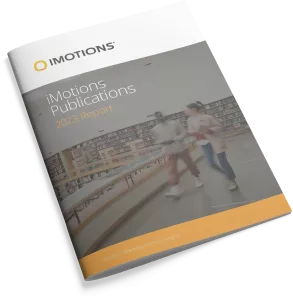-
Children’s physiological and behavioural response evoked by the observation, olfaction, manipulation, and consumption of food textures. Part 1: liquid products
Children are thought to prefer homogeneous and simple textures that are easy to manipulate in the mouth. Although scientific research has been done on children’s acceptance for food textures, there is a lack of knowledge regarding the emotional response elicited by textures in this group of population. Physiological and behavioural methods could be an appropriate […]
-
Mobile Eye-Tracking as a Research Method to Explore the D/Deaf Experience at Arts and Cultural Venues
D/deaf activists have consistently lamented their exclusion from the decision-making process by service providers. Accessibility is only effective when designed with contributions from those affected by the perceived or known barrier. This paper redresses the historic absence of the D/deaf paradigm, and recenters the focus to the individual’s perspective of accessibility requirements by developing a […]
-
Bridging social marketing and technology in the disability field: an empirical study on the role of cybernetic avatar and social inclusion
Purpose This study aims to determine the perception and attitude of consumers toward the presence of cybernetic avatars (CAs) as part of a social inclusion initiative. Design/methodology/approach A mixed method was used to conduct the study using facial recognition expressions and surveys. Three studies were conducted. Study 1 examines consumers’ attitudes and perceptions of a […]
-
Differentiating Use of Facial Expression between Individuals with and without Traumatic Brain Injury Using Affectiva Software: A Pilot Study
This study investigated the feasibility of using an automated facial coding engine, Affectiva (integrated in iMotions, version 8.2), for evaluating facial expression after traumatic brain injury (TBI). An observational cross-sectional study was conducted based on facial expression data from videos of participants with TBI and control participants. The aims were to compare TBI and control […]
-
Granting a Better Verdict of the Mini-Mental State Examination (MMSE) With New Technologies
There are millions of people in the world who have been diagnosed with dementia and this condition not only directly affects the patient, but also their family members and caregivers; That is why it is sought to have a verdict in which it can be reliably seen if a person suffers from dementia. The way […]
-
Clients’ Facial Expressions of Self-Compassion, Self-Criticism, and Self-Protection in Emotion-Focused Therapy Videos
Clients’ facial expressions allow psychotherapists to gather more information about clients’ emotional processing. This study aims to examine and investigate the facial Action Units (AUs) of self-compassion, self-criticism, and self-protection within real Emotion-Focused Therapy (EFT) sessions. For this purpose, we used the facial analysis software iMotions. Twelve video sessions were selected for the analysis based […]
-
Towards Context-Aware Facial Emotion Reaction Database for Dyadic Interaction Settings
Emotion recognition is a significant issue in many sectors that use human emotion reactions as communication for marketing, technological equipment, or human–robot interaction. The realistic facial behavior of social robots and artificial agents is still a challenge, limiting their emotional credibility in dyadic face-to-face situations with humans. One obstacle is the lack of appropriate training […]
-
Multimodal Approach to Measuring Cognitive Load Using Sternberg Memory and Input Diagrammatic Reasoning Tests
Results of a study of cognitive load using multimodal biometric techniques including electrocardiography, electroencephalography and galvanic skin response are presented in the paper. Thirty student volunteers took part in an experiment conducted on the iMotions integrated biometric platform in a laboratory setting. Two types of tests were employed as research stimuli, namely the Sternberg memory […]
-
Does electricity consumption make happy? The emotional dimensions of time-scaled electricity consumption graphs for household appliances
Due to the current situation regarding climate change, smart home energy management systems help to provide an overview of a household’s electricity consumption at appliance level by means of time-scaled visualizations. Such electricity consumption graphs need to be visually appealing to unleash potentials for a positive contribution to energy transition. Triggered emotions in particular play a […]
-
The effect of the modality principle to support learning with virtual reality: An eye-tracking and electrodermal activity study
Virtual reality (VR) is considered a promising approach to support learning. An instructional design is essential to optimize cognitive processes. Studies show that VR has unique instructional and pedagogical requirements. To evaluate the effectiveness and applicability of the modality principle, which was previously validated in 2D classic multimedia, for learning with VR. The modality principle […]
Research Report 2023
In-depth look at the scientific landscape as powered by iMotions software, showcasing groundbreaking research and the impact of our tools in various scientific and industrial fields.

Share Your Research

850+ universities worldwide with an iMotions human behavior lab
73 of the top 100 highest ranked universities
710+ published research papers using iMotions
iMotions is used for some of the most interesting human behavior research studies carried out by top researchers around the world. Contact us to have your publication featured here.
The authors of these publications have used iMotions as a software tool within their research.
“Software should be cited on the same basis as any other research product such as a paper or a book; that is, authors should cite the appropriate set of software products just as they cite the appropriate set of papers” (Katz et al., 2020).
We therefore encourage you to cite the use of iMotions where appropriate.
How to cite iMotions
APA
iMotions (10), iMotions A/S, Copenhagen, Denmark, (2024).
Note: adjust the version and year where relevant.
5 Most Popular Blogs
Learn How to Conduct Human Behavior Research with iMotions
Publications
Read publications made possible with iMotions
Blog
Get inspired and learn more from our expert content writers
Newsletter
A monthly close up of latest product and research news





